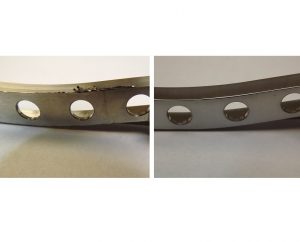Machined metal parts will often end up with excess material, called “burrs.” These burrs can be created by grinding, molding, laser cutting, punching, sawing, routing, drilling or shearing – really any type of machining. While high-quality equipment can help reduce the amount of burrs you end up with, no matter how sharp or precise your equipment is, the chances of burrs are never entirely eliminated. Luckily, deburring metal is a common practice that’s highly effective in removing flaws or imperfections to your piece! Keep reading to learn more about what goes into deburring for metal fabrication.
What is Deburring?
 Metal deburring is a process that removes imperfections, such as sharp or unsightly burrs, producing a smooth edge and higher-quality look. Leaving burrs can compromise the finished part if they are not properly removed before final metal finishing.
Metal deburring is a process that removes imperfections, such as sharp or unsightly burrs, producing a smooth edge and higher-quality look. Leaving burrs can compromise the finished part if they are not properly removed before final metal finishing.
Deburring metal is essential for applications that require precision, as displaced metal in the form of burrs or imperfections can lead to hazards, compromised functionality or unreliable equipment. An example of this is the medical industry, regarding equipment such as surgical tools – a jagged edge could easily cause internal damage to a patient receiving surgery.
Some additional part quality issues that can be caused by burrs include:
- Material failures (cracks, splitting, etc.)
- Fastener damage or instability
- Increased surface wear
- Increased corrosion, heat and friction susceptibility
- Lubrication issues
- General diminished safety during part use
Methods of Deburring Metal
There are several methods of burr removal out there, but not all of them are cost-effective or applicable to a variety of surfaces. At RP Abrasives, we got our start with deburring metal and have dedicated ourselves to finding the most effective processes without compromising the integrity or tolerance of parts. The deburring processes we use in-house are hand deburring and batch deburring.
Hand Deburring
Hand deburring requires careful attention, with a variety of tools and methods coming into play, each playing a unique role. It’s a bit of a misnomer, because oftentimes there are machines used alongside handheld tools to get each finished part perfect. This deburring method can range from a single-step to a multi-step process depending on the application.
Batch Deburring
Batch deburring is also commonly referred to as mass finishing. While the batch deburring process can be varied, like hand deburring, the difference between the two is the uniformity of the finished product. When a group of parts are deburred together for a length of time, you’re not only getting the consistency across parts but also the added benefit of cost-effectiveness of deburring all at once.
The batch deburring method generally uses a tumbler at its base, though type can vary between centrifugal, high energy and vibratory. The type of tumbler and media used to deburr will depend on your application – what size it is, what the part is made from, and how much deburring it will need.
Tumbling is the most common method of batch deburring, but there are also alternatives that include basket blasting or even ultrasonic deburring.
Contact the Experts at RP Abrasives
If you’re unsure about what kind of deburring or finishing may be best for your application, simply reach out to our expert team at RP Abrasives. With a commitment to excellence, we can achieve just about any finish for your unique needs, serving as a “one-stop shop” for metal finishing services. Whether you are interested in deburring metal, passivating parts or polishing, request a project quote from us today!
